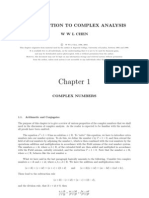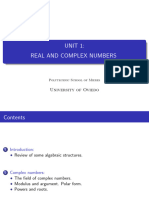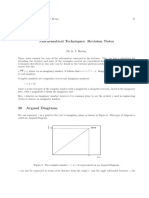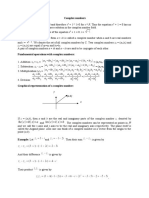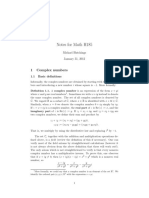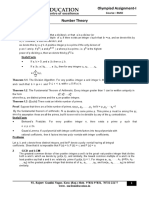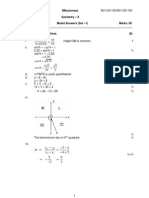Mathematics & Statistics For Managers: Part 01 1 Number System
Mathematics & Statistics For Managers: Part 01 1 Number System
Uploaded by
Syed TabrezCopyright:
Available Formats
Mathematics & Statistics For Managers: Part 01 1 Number System
Mathematics & Statistics For Managers: Part 01 1 Number System
Uploaded by
Syed TabrezOriginal Description:
Original Title
Copyright
Available Formats
Share this document
Did you find this document useful?
Is this content inappropriate?
Copyright:
Available Formats
Mathematics & Statistics For Managers: Part 01 1 Number System
Mathematics & Statistics For Managers: Part 01 1 Number System
Uploaded by
Syed TabrezCopyright:
Available Formats
Lecture Notes Basic Mathematics: Part 01 Jun 2017
Mathematics & Statistics for Managers: Part 01
1 Number System
We denote the set of integers by Z: {..., 3, 2, 1, 0, 1, 2, 3, ...}.
The system Z has two basic operations of addition and multiplication and these operations satisfy
the following properties.
1. Closure Law for Addition: For all a, b Z, a + b Z.
2. Associative Law for Addition: For all a, b, c Z, (a + b) + c = a + (b + c).
3. Commutative Law for Addition: For all a, b Z, a + b = b + a.
4. Identity for Addition: There exists 0 Z such that for all a Z, 0 + a = a.
5. Inverses under Addition: For all a Z there exists a Z such that a + (a) = 0.
6. Closure Law for Multiplication: For all a, b Z, ab Z.
7. Associative Law for Multiplication: For all a, b, c Z, (ab)c = a(bc).
8. Commutative Law for Multiplication: For all a, b Z, ab = ba.
9. Identity for Multiplication: There exists 1 Z such that 1 = 0 and, for all a Z, 1a = a.
10. Distributive Law: For all a, b, c Z, a(b + c) = ab + ac.
11. Cancellation Law: For all a, b, c Z, ab = 0 implies that a = 0 or b = 0.
In addition to the two binary operations the system Z has a subset N satisfying the following proper-
ties. This is the set {0, 1, 2, 3, ...} and it is called the set of natural numbers.
1. For all a, b N, ab N.
2. For all a Z, exactly one of a and a belongs to N.
3. For all a N, a + 1 N.
4. If S is a subset of N and:
(a) 0 S and
(b) a S implies that a + 1 S
then S = N.
We call the non-zero elements of N positive. All other numbers, except for zero, are called negative.
So, there are three basic sets of numbers according to this classification:
{negative numbers}, {0}, {positive numbers}.
Theorem 1.1. Principle of Induction: Suppose S(n) is a statement depending on some parameter n N. If
S(0) is true and for all n, S(n) implies S(n + 1), then S(n) is true for all n.
An integer m divides and integer n if n = mq for some integer q. We write this as m|n. Equivalently
we can say that n is a multiple of m.
When two numbers differ by a multiple of m they will leave the same remainder when you divide
by m and we say that they are congruent modulo m. The number m is called the modulus. If two
numbers are congruent modulo m, they are the same in some sense, even if they are not exactly the
same. So we use a variation on the equals sign. We write a b. But the modulus is important so we
write a b(mod m).
We therefore have lots of different ways of saying the same thing:
Bhattacharjee K. K. Institute for Financial Management & Research Page 1
Lecture Notes Basic Mathematics: Part 01 Jun 2017
a b(mod m),
a = b + mq for some q Z,
m|(ab),
a, b leave the same remainder when divided by m.
If the remainder is zero then m divides n. We denote the set of divisors of n by D(n) and the set of
multiples of n by nZ. The set of common divisors of m, n is simply D(m) D(n).
Suppose m, n are non-zero integers. Then D(m) D(n) is finite. An element of this set of largest
absolute value is called a greatest common divisor of m, n.
Let m and n be integers. We say that the positive integer l is the least common multiple of m and
n, if
1. l is a multiple of both m and n,
2. if l is a positive multiple of both m and n then l l .
We define a positive number to be prime if it has exactly 2 positive divisors. Note that this rules out
1. Numbers that are not prime, other than the three special numbers -1, 0, and 1, are called composite.
There are four basic sets of numbers according to this classification:
{0}, {1}, {prime numbers}, {composite numbers}.
A fraction is an expression of the form mn . The number on the top is called the numerator and the
number on the bottom is called the denominator. When the numerator and denominator are integers,
we call the fraction a rational number. The rational number set is denoted by Q. The irrational
numbers can not be represented in the form of m n , where m and n are integers and prime to each
other. The irrational number set is denoted by I. Collection of both rational and irrational numbers
constructs the set called real numbers. The real number set is donated by R.
To solve the problem of certain quadratic equations having no solution we invent the number i
with the property that i = 1. All the numbers of the form z = a + bi are called complex numbers
2
where a, b are real. These are made up of two parts, a real (Re(z) = a)and an imaginary number
(Im(z) = b). Geometric interpretation of complex number is shown in Figure 1.
Figure 1: Complex plane.
The coordinates of the point that represents a complex number are its real and imaginary parts.
But theres another set of coordinates that is useful in many contexts polar coordinates. If r is the
distance of the point P (x, y) from the origin and is the angle between OP and the positive x-axis (O
Bhattacharjee K. K. Institute for Financial Management & Research Page 2
Lecture Notes Basic Mathematics: Part 01 Jun 2017
being the origin) then x = r cos() and y = r sin(). The polar coordinates of the point are (r, ). If this
point represents the complex number z = x + iy the modulus of z is defined to be r and the argument
of z is defined to be . We denote
the modulus of z by |z| and the argument of z by Arg(z).
If z = x + iy then |z| = x + y 2 and x = r cos(), y = r sin() where r = |z| and = Arg(z).
2
Theorem 1.2. If z1 and z2 are two complex numbers, then |z1 .z2 | = |z1 |.|z2 |.
The conjugate of the complex number z = x + iy is z = x iy. Geometrically its the mirror image
of z in the real axis.
Theorem 1.3. For a complex number z, z z = z2 and z + z = 2Re(z).
Theorem 1.4. For all complex numbers z1 , z2 , z:
z1 + z2 = z1 + z2 ;
z1 z2 = z1 z2 ;
z = z;
1 z
= .
z z2
Theorem 1.5. If the complex number z is a solution of the polynomial equation
an xn + an1 xn1 + ... + a1 x + a0 = 0
and a0 , a1 , ..., an are all real then z is also a solution.
If z = x + iy and the modulus of z is r and the argument is then z = r cos() + ir sin() =
r(cos() + i sin()). Sometimes we abbreviate cos() + i sin() to cis(), so z = rcis(). This is called
the polar form.
Theorem 1.6. cis(1 + 2 ) = cis(1 ).cis(2 ).
Theorem 1.7. De Moivres Theorem (cos() + i sin())n = cos(n) + i sin(n) for all integer n.
( )
Theorem 1.8. The n-th roots of rcis(), for r > 0 are r1/n cis +2k
n for k = 0, 1, ..., n 1.
2 Basic Algebraic Identities, Operations, & Equations
Theorem 2.1. For all real numbers x, y:
(x + y)2 = x2 + 2xy + y 2 ;
(x y)2 = x2 2xy + y 2 ;
x2 y 2 = (x y)(x + y);
x3 y 3 = (x y)(x2 + xy + y 2 );
x3 + y 3 = (x + y)(x2 xy + y 2 ).
a
Theorem 2.2. If a, b, c and d are numbers such that b and d are non-zero and b = dc , then
a+b c+d
= ;
b d
ab cd
= ;
b d
a a + kb c + kd
For k = , = ;
b a kb c kd
b a a + kc
For k = , = .
d b b + kd
Bhattacharjee K. K. Institute for Financial Management & Research Page 3
Lecture Notes Basic Mathematics: Part 01 Jun 2017
A linear equation (in one variable) has the form ax + b = c. If a = 0 we can solve for x, and there
is just one solution.
A quadratic equation has the form ax2 + bx + c = 0 where a, b, c are constants (real numbers) and
where a = 0. A common way to solve a quadratic is to factorize the left-hand side.
Theorem 2.3. If b2 4ac 0, the solution to the quadratic ax2 + bx + c = 0 are:
b b2 4ac
x=
2a
Theorem 2.4. If and are the roots of the quadratic ax2 + bx + c then:
b c
+ = and = .
a a
A surd is a square root, cube root etc. An equation involving surds can often be solved by squaring,
or raising to some other power, both sides of the equation to get rid of the surds. But beware! In the
process of squaring we may pick up solutions that do not satisfy the original equation.
3 Logarithm & Exponents
If x is any number, and n is a positive integer, we define the n-th power of x by xn .
Theorem 3.1. Index Laws: For all integers m, n and all real numbers x, y we have:
(xm )n = xmn ;
1
xn = n ;
x
(xy)n = xn y n ;
xm xn = xm+n .
If b > 1, the logarithm of x to the base b is defined to be that power of b which exactly equals x. It
is written logb x.
Theorem 3.2. For all b, c, x, y with b, c > 0:
logb (xy) = logb x + logb y;
( )
x
logb = logb x logb y;
y
logb (xy ) = y. logb x;
logc x
logb x = .
logc b
4 Geometry
The Euclidean plane, E, is defined by following rules or axioms
1. For any two distinct points there is exactly one line which contains them both.
2. To any two distinct points there corresponds a unique positive number. The unique positive
number corresponding to a pair of distinct points is called the distance between the points. The
distance between a point and itself is defined to be 0. The distance between any two points A
and B is denoted d(A, B) or |AB|.
Bhattacharjee K. K. Institute for Financial Management & Research Page 4
Lecture Notes Basic Mathematics: Part 01 Jun 2017
3. The points on a line can be placed into a one to one correspondence with the real numbers
such that the distance between two points is the absolute value of the difference between their
corresponding numbers.
An angle is the union of two rays having a common end point which are not contained in a single
line. The rays are called the sides of the angle and the common endpoint is called the vertex of the
angle. If the two sides of an angle are AB and AC we denote this angle as BAC. To each angle there
corresponds a unique real number strictly between 0 and 180.
A and B are called supplementary, if |A| + |B| = 180.
A and B are called complementary, if |A| + |B| = 90.
If A, B, C are non-collinear points then the union of the segments AB, BC, CA is called a triangle
and denoted ABC, i.e. ABC = AB BC CA. The segments AB, BC, CA are called the sides of
the triangle. The angles of the triangle ABC are BAC, ABC, and ACB.
In triangles ABC and A B C , if AB A B , BC B C , CA C A , A A , B
B , and C C then we say that triangle ABC and A B C are congruent triangles and write
ABC A B C .
If AB A B , BC B C , and B B then ABC A B C .
A polygon is any figure consisting entirely of segments A1 A2 , A2 A3 , ..., An1 An , An A1 having the
property that no two of these segments intersect except at their endpoints as specified, and no two
segments that intersect are collinear. The segments Ai Aj are called the sides of the polygon and the
points A1 , A2 , An are called its vertices.
obtuse angle: an angle whose measure is greater than 90
acute angle: an angle whose measure is less than 90
adjacent angles: two angles that share a common ray
isosceles triangle: a triangle with two congruent angles
equilateral triangle: a triangle with three congruent sides
scalene triangle: a triangle in which no two sides are congruent
quadrilateral: a polygon with exactly four sides
trapezoid: a quadrilateral with exactly one pair of parallel sides
isosceles trapezoid: a trapezoid having two angles that share one of the sides in the parallel pair
parallelogram: a quadrilateral with two pairs of parallel sides
rectangle: a quadrilateral with four congruent angles
rhombus: a quadrilateral with four congruent sides
square: a quadrilateral that is both a rectangle and a rhombus
regular polygon: a polygon with n sides having all sides and all angles congruent
Circle: a figure consisting of all points that are a fixed positive distance r from a given point O.
We if A is a point on the circle with center O and radius r we designate this circle as OA and write
| OA| = r.
center: the point O in the definition of a circle.
radius: any segment having the center and a point on the circle as endpoints. The length of any
radius is also referred to as the radius of the circle.
Bhattacharjee K. K. Institute for Financial Management & Research Page 5
Lecture Notes Basic Mathematics: Part 01 Jun 2017
circle congruence: two circles are congruent if and only if their radii are the same length. Every
circle is congruent to itself.
chord: a segment connecting two distinct points on a circle.
diameter: a chord that contains the center. The length of any diameter is also called the diameter
of the circle.
tangent: a line that intersects a circle at exactly one point.
tangent circles: two circles that intersect at exactly one point.
central angle: an angle whose vertex is the center of a given circle.
arc: the set of points on a circle that are in the interior of or on a central angle or the set of points
on a circle that are in the exterior of or on a central angle.
measure of an arc: the measure of the corresponding central angle if the arc is in the interior of
the central angle and 360 minus the measure of the central angle otherwise.
References
Lial, M.L., Hornsby, J. and McGinnis, T. (2012). Begining and Intermediate Algebra, Addison-
Wesley.
McKeague, C.P. (2008). Elementary and Intermediate Algebra, Thomsom.
Kaufmann, J.E. and Schwitters, K.L. (2012). Elementary and Intermediate Algebra, Brooks/Cole,
Cengage Learning.
www.sosmath.com.
www.mathportal.org.
Bhattacharjee K. K. Institute for Financial Management & Research Page 6
You might also like
- Krantz Real Analysis 4e Student Solutions ManualDocument103 pagesKrantz Real Analysis 4e Student Solutions ManualThiago Nobre100% (1)
- Ma 204 IitbDocument21 pagesMa 204 IitbsiddharthballalNo ratings yet
- Complex NumbersDocument12 pagesComplex Numbersnhlanhlanhleko11No ratings yet
- Introduction To Complex Analysis: WwlchenDocument4 pagesIntroduction To Complex Analysis: WwlchendumpscribdNo ratings yet
- Introduction To Complex Analysis (Lecture Notes, 2003) ChenDocument194 pagesIntroduction To Complex Analysis (Lecture Notes, 2003) Chenapi-3840623No ratings yet
- Slides VB Inz MM 02 Kompl BR - PsDocument142 pagesSlides VB Inz MM 02 Kompl BR - PsVladimir BalticNo ratings yet
- Unit1 NumbersDocument33 pagesUnit1 NumbersNaiara Fernández FernándezNo ratings yet
- CBR Kalkulus Aljabar LinearDocument6 pagesCBR Kalkulus Aljabar LinearAndre SitohangNo ratings yet
- Mathematical Techniques: Revision Notes: DR A. J. BevanDocument8 pagesMathematical Techniques: Revision Notes: DR A. J. BevanRoy VeseyNo ratings yet
- Enrichment Lectures 2010 Some Facts and Problems About PolynomialsDocument32 pagesEnrichment Lectures 2010 Some Facts and Problems About PolynomialsVinay MishraNo ratings yet
- Quaternion ConradDocument19 pagesQuaternion ConradWalter ariel BayaNo ratings yet
- Real Analysis: 1 Real and Complex Number SystemsDocument5 pagesReal Analysis: 1 Real and Complex Number SystemsNJSchandlerNo ratings yet
- Properties of Integers: 1 The Well-Ordering Principle: Mathematical InductionDocument8 pagesProperties of Integers: 1 The Well-Ordering Principle: Mathematical Inductionb9902233No ratings yet
- Maths Anciliary Sem I - Clas Abs - Jul 14Document38 pagesMaths Anciliary Sem I - Clas Abs - Jul 14China VpnNo ratings yet
- Lecture 13-Complrx NumberDocument7 pagesLecture 13-Complrx NumberbananaNo ratings yet
- E Notes Vol 1Document476 pagesE Notes Vol 1sahildarji806No ratings yet
- ComplexnumberDocument11 pagesComplexnumberomsaiboggala811No ratings yet
- MATH1411 Section 1Document27 pagesMATH1411 Section 1demorachNo ratings yet
- 1 Review of Complex NumbersDocument8 pages1 Review of Complex NumbersNasreen AliNo ratings yet
- Clas 11 LMRDocument378 pagesClas 11 LMRChandan MahtoNo ratings yet
- Complex Numbers in TrigonometryDocument13 pagesComplex Numbers in TrigonometryHimanshu TiwariNo ratings yet
- Glosario de Conjuntos y NúmerosDocument4 pagesGlosario de Conjuntos y NúmerosDaniel GraNo ratings yet
- Baltic Way 2016 - SolutionsDocument10 pagesBaltic Way 2016 - SolutionsgeorgeNo ratings yet
- B044Document47 pagesB044AnubhavNo ratings yet
- Complex Analysis I Lec NotesDocument25 pagesComplex Analysis I Lec Notesaego2972No ratings yet
- Algebra I - I (Wilkins)Document20 pagesAlgebra I - I (Wilkins)Enrique Aviles MendozaNo ratings yet
- Complex Numbers HSNDocument3 pagesComplex Numbers HSNLNo ratings yet
- Cambridge Complex Numbers 2Document27 pagesCambridge Complex Numbers 2Yeet DeetNo ratings yet
- Additional Mathematics 4038/01: Cedar Girls' Secondary School Preliminary Examination Secondary FourDocument7 pagesAdditional Mathematics 4038/01: Cedar Girls' Secondary School Preliminary Examination Secondary FournicomiaNo ratings yet
- Notes1 PDFDocument22 pagesNotes1 PDFvrtvtNo ratings yet
- MathsDocument9 pagesMathsAdhiraj SengarNo ratings yet
- Chapter 1Document26 pagesChapter 1diyahNo ratings yet
- Complex Numbers and FunctionsDocument15 pagesComplex Numbers and FunctionsGaurav SahuNo ratings yet
- Lecture1 Real Numbers StudentsDocument23 pagesLecture1 Real Numbers StudentsredalahacaniNo ratings yet
- Complex Numbers - MDBDocument25 pagesComplex Numbers - MDBaruodasNo ratings yet
- Euler PDFDocument13 pagesEuler PDFElumalaiNo ratings yet
- Complex ReviewDocument8 pagesComplex Reviewdevendra416No ratings yet
- Discrete Mathematics HW2: X X X XDocument5 pagesDiscrete Mathematics HW2: X X X Xchungwon.lee04No ratings yet
- Math 151 Algebra2016 1Document112 pagesMath 151 Algebra2016 1Lord Ponkor Offin100% (1)
- Complex NumbersDocument12 pagesComplex NumbersSanjoy Brahma100% (1)
- Week 12 PDFDocument8 pagesWeek 12 PDFDPNo ratings yet
- Maths Smart Session With AnnotationsDocument349 pagesMaths Smart Session With AnnotationsHarsh RanjanNo ratings yet
- Analytic Number Theory NoteDocument36 pagesAnalytic Number Theory Noteabdullah ghamdiNo ratings yet
- Inmo PDFDocument47 pagesInmo PDFAjjxNo ratings yet
- IOQm TheoryDocument49 pagesIOQm Theorydeepnil.rayNo ratings yet
- Lecture 1Document4 pagesLecture 1Keerthana SundararajanNo ratings yet
- Chapter2 ComplexeةDocument6 pagesChapter2 Complexeةoussamaregcr7No ratings yet
- Mathematics IA Algebra and Geometry (Part I) Michaelmas Term 2002Document30 pagesMathematics IA Algebra and Geometry (Part I) Michaelmas Term 2002Pooja SinhaNo ratings yet
- Solutions To The 71st William Lowell Putnam Mathematical Competition Saturday, December 4, 2010Document5 pagesSolutions To The 71st William Lowell Putnam Mathematical Competition Saturday, December 4, 2010atiggy05No ratings yet
- Number TheoryDocument6 pagesNumber TheoryPoojaMaheshwariNo ratings yet
- Unit 2 MathematicsDocument112 pagesUnit 2 MathematicsAman Pratap SinghNo ratings yet
- Complex Till DiffDocument12 pagesComplex Till Diffvikas rajpootNo ratings yet
- MA547 Lecture SummaryDocument21 pagesMA547 Lecture SummaryVikas RajpootNo ratings yet
- Complex Numbers: 1 The Arithmetic Form of A Complex NumberDocument25 pagesComplex Numbers: 1 The Arithmetic Form of A Complex Numberlhau_8No ratings yet
- Complex NumbersDocument12 pagesComplex NumbersHoria HamoucheNo ratings yet
- Hw2 Solutions Section 16 13 Let G Be The Additive Group of RealDocument5 pagesHw2 Solutions Section 16 13 Let G Be The Additive Group of RealSumanta MannaNo ratings yet
- De Moiver's Theorem (Trigonometry) Mathematics Question BankFrom EverandDe Moiver's Theorem (Trigonometry) Mathematics Question BankNo ratings yet
- Trigonometric Ratios to Transformations (Trigonometry) Mathematics E-Book For Public ExamsFrom EverandTrigonometric Ratios to Transformations (Trigonometry) Mathematics E-Book For Public ExamsRating: 5 out of 5 stars5/5 (1)
- Cheng Luo-ThesisDocument50 pagesCheng Luo-ThesisSyed TabrezNo ratings yet
- First Look: Ten QuestionsDocument15 pagesFirst Look: Ten QuestionsSyed TabrezNo ratings yet
- The Climate-Nature Nexus: Implications For The Financial SectorDocument38 pagesThe Climate-Nature Nexus: Implications For The Financial SectorSyed TabrezNo ratings yet
- JS BinDocument1 pageJS BinSyed TabrezNo ratings yet
- Measurement and Scaling: Fundamentals and Comparative ScalingDocument14 pagesMeasurement and Scaling: Fundamentals and Comparative ScalingSyed TabrezNo ratings yet
- Factor AnalysisDocument3 pagesFactor AnalysisSyed TabrezNo ratings yet
- Day 3 Improving AgriculturalDocument28 pagesDay 3 Improving AgriculturalSyed TabrezNo ratings yet
- Questionnaire and Form DesignDocument22 pagesQuestionnaire and Form DesignSyed TabrezNo ratings yet
- Defining The Marketing Research Problem and Developing An ApproachDocument22 pagesDefining The Marketing Research Problem and Developing An ApproachSyed TabrezNo ratings yet
- 06 Calculating NPV ShellDocument1 page06 Calculating NPV ShellSyed TabrezNo ratings yet
- CH 456Document8 pagesCH 456Syed TabrezNo ratings yet
- Causal Research Design: ExperimentationDocument15 pagesCausal Research Design: ExperimentationSyed TabrezNo ratings yet
- Business Statistics (B.com) P 1Document99 pagesBusiness Statistics (B.com) P 1Syed TabrezNo ratings yet
- Customer Retention in Telecom Industry: Dolly MallaDocument8 pagesCustomer Retention in Telecom Industry: Dolly MallaSyed TabrezNo ratings yet
- Verizon Communications, Inc: Implementing A Human Resources Balanced ScorecardDocument14 pagesVerizon Communications, Inc: Implementing A Human Resources Balanced ScorecardSyed TabrezNo ratings yet
- 18 Vol 4 No 2Document11 pages18 Vol 4 No 2Syed TabrezNo ratings yet
- TrigonometryDocument15 pagesTrigonometryJhon Christian CabintoyNo ratings yet
- Lesson Plan 1 - PolygonsDocument3 pagesLesson Plan 1 - Polygonsapi-534905186No ratings yet
- Model Answer Geometry Set IDocument12 pagesModel Answer Geometry Set ISachinNo ratings yet
- Area of Shaded Region AnswersDocument1 pageArea of Shaded Region AnswersSemone ChunilalNo ratings yet
- 3D Geometry: α α α α, ββββ, γγγγ are angle made by a line with positive directions of x, y and zDocument35 pages3D Geometry: α α α α, ββββ, γγγγ are angle made by a line with positive directions of x, y and zpreetamNo ratings yet
- Kepler Triangle and TilingDocument6 pagesKepler Triangle and TilingDr Srinivasan Nenmeli -K0% (1)
- 22Document3 pages22JanMark Dela Cerna ManguilimutanNo ratings yet
- Shapes Worksheets PackDocument6 pagesShapes Worksheets PackSoma SalimNo ratings yet
- AreasDocument3 pagesAreasMarvin KalnganNo ratings yet
- Trigonometry TestDocument2 pagesTrigonometry TestJeff BuenoNo ratings yet
- Geometry Problems Foundation Questions MMEDocument6 pagesGeometry Problems Foundation Questions MMESouvik GhoshNo ratings yet
- Oblique SphericalDocument5 pagesOblique SphericalInriko Rico Castillo100% (1)
- MC Sir SheetDocument17 pagesMC Sir Sheetabhijeet100% (1)
- Math 5 Lesson 4.2 PolygonsDocument28 pagesMath 5 Lesson 4.2 PolygonsLilibeth BernabeNo ratings yet
- Math 9 4th QDocument3 pagesMath 9 4th QMari Zechnas OsnolaNo ratings yet
- MATH10 2nd QuarterDocument40 pagesMATH10 2nd QuarterCj Gan100% (1)
- Module 16-Simple and Compound CurvesDocument5 pagesModule 16-Simple and Compound CurvesGerovic ParinasNo ratings yet
- 8 1 Christmas Activity The Pythagorean Theorem and Its Converse 2Document5 pages8 1 Christmas Activity The Pythagorean Theorem and Its Converse 2glenn maltoNo ratings yet
- Polygons Math O Levels 4024Document5 pagesPolygons Math O Levels 4024maliikimaad100% (2)
- Activity For Cosine and Sine LawDocument4 pagesActivity For Cosine and Sine LawOribe, Narciso A.No ratings yet
- NCERT Exemplar Solution For Class 10 Maths Chapter 9 CirclesDocument19 pagesNCERT Exemplar Solution For Class 10 Maths Chapter 9 CirclesBasil SkariaNo ratings yet
- GeometryDocument16 pagesGeometryJaime Candelaria de Guzman Jr.100% (1)
- B A Judson 1: Not Drawn AccuratelyDocument5 pagesB A Judson 1: Not Drawn AccuratelyAnonymous GNWnQac0% (1)
- NZ Qualifications Authority LVL 1 Math/Stats Exam 2017Document16 pagesNZ Qualifications Authority LVL 1 Math/Stats Exam 2017The Guardian89% (35)
- Sanjeev Kumar-Objective Physics For The JEE Main 2015-Pearson India (2014)Document40 pagesSanjeev Kumar-Objective Physics For The JEE Main 2015-Pearson India (2014)AjayNo ratings yet
- Geom ConicsDocument12 pagesGeom ConicsAyan KhanNo ratings yet
- Star Polygons 12 - 5Document10 pagesStar Polygons 12 - 5sergio.tyson.bolaNo ratings yet
- Sierpinski TriangleDocument2 pagesSierpinski TrianglehorselvrNo ratings yet
- TrianglesDocument62 pagesTrianglesFatya EyvazovaNo ratings yet
- VECTORS GCSE Question - Yr 9 - Extension SheetDocument1 pageVECTORS GCSE Question - Yr 9 - Extension SheetRyan ChristianNo ratings yet




